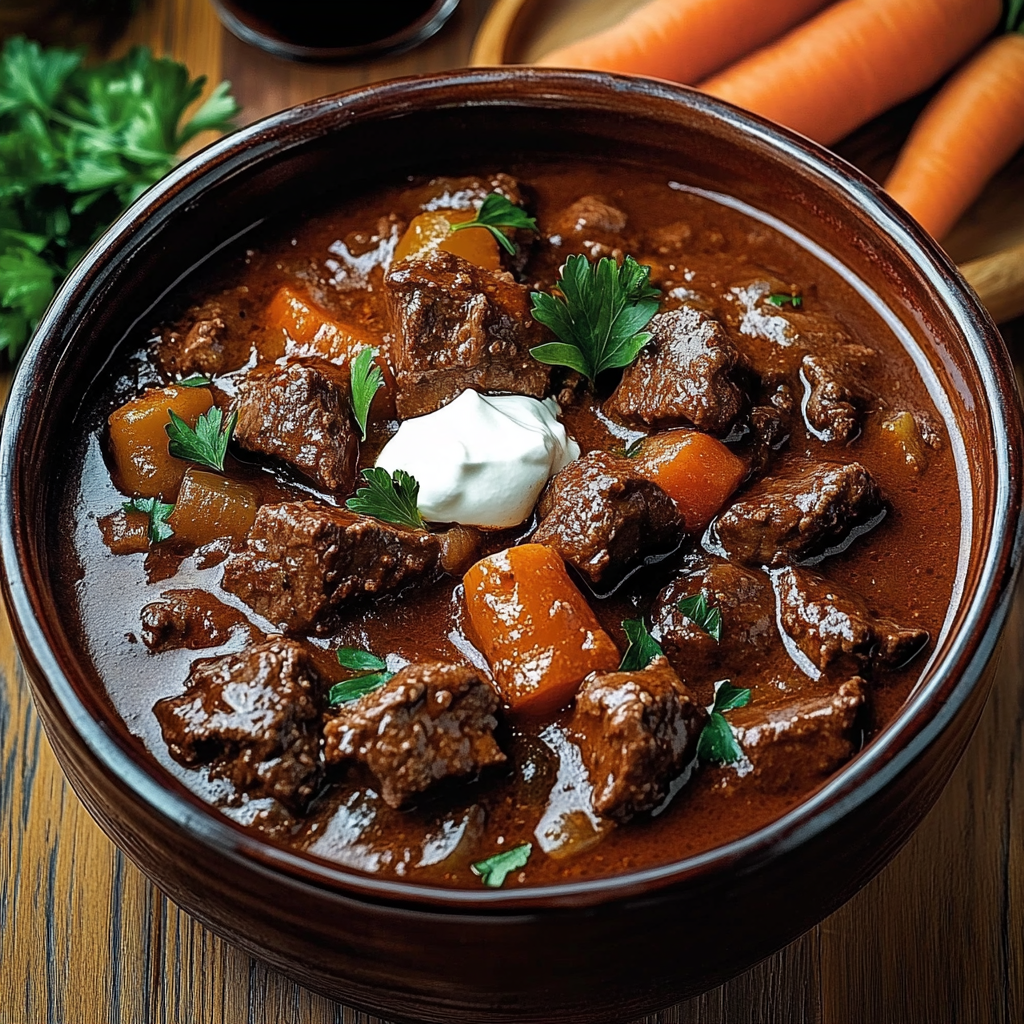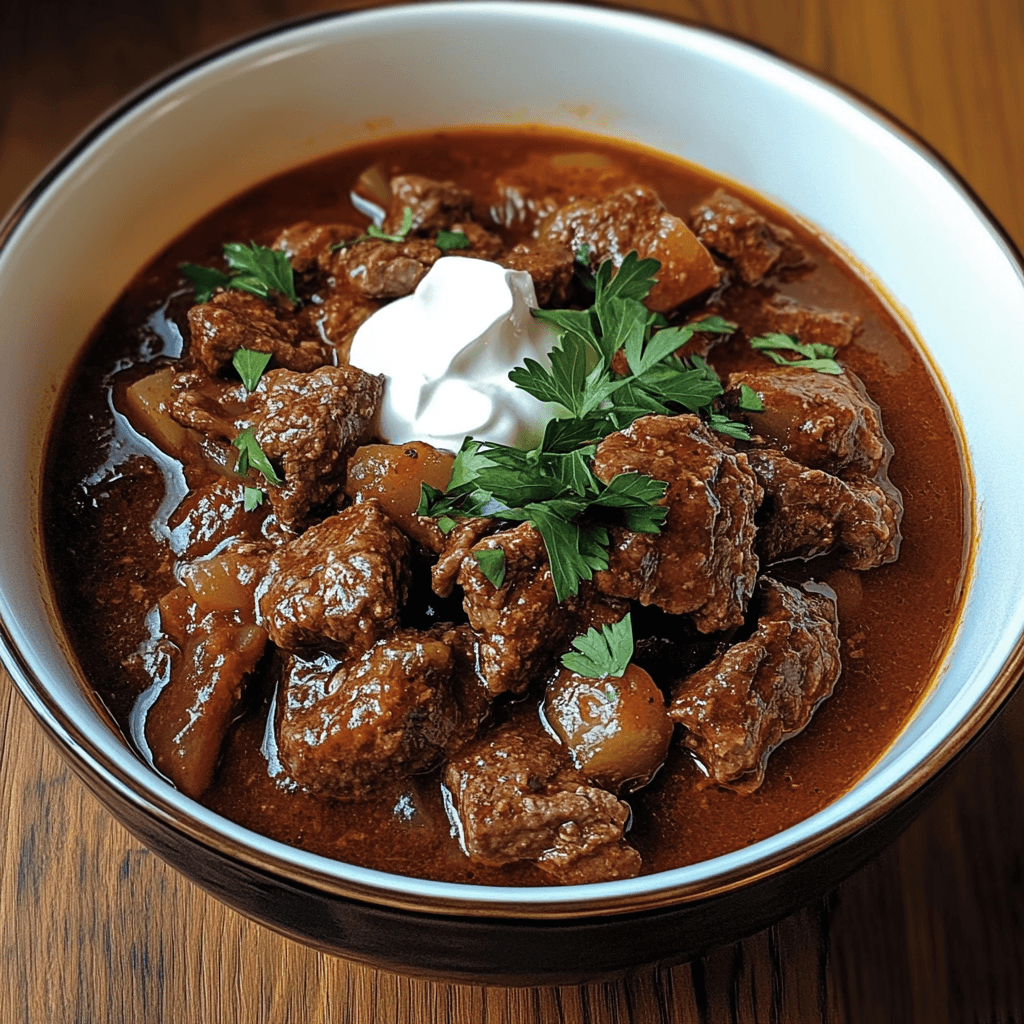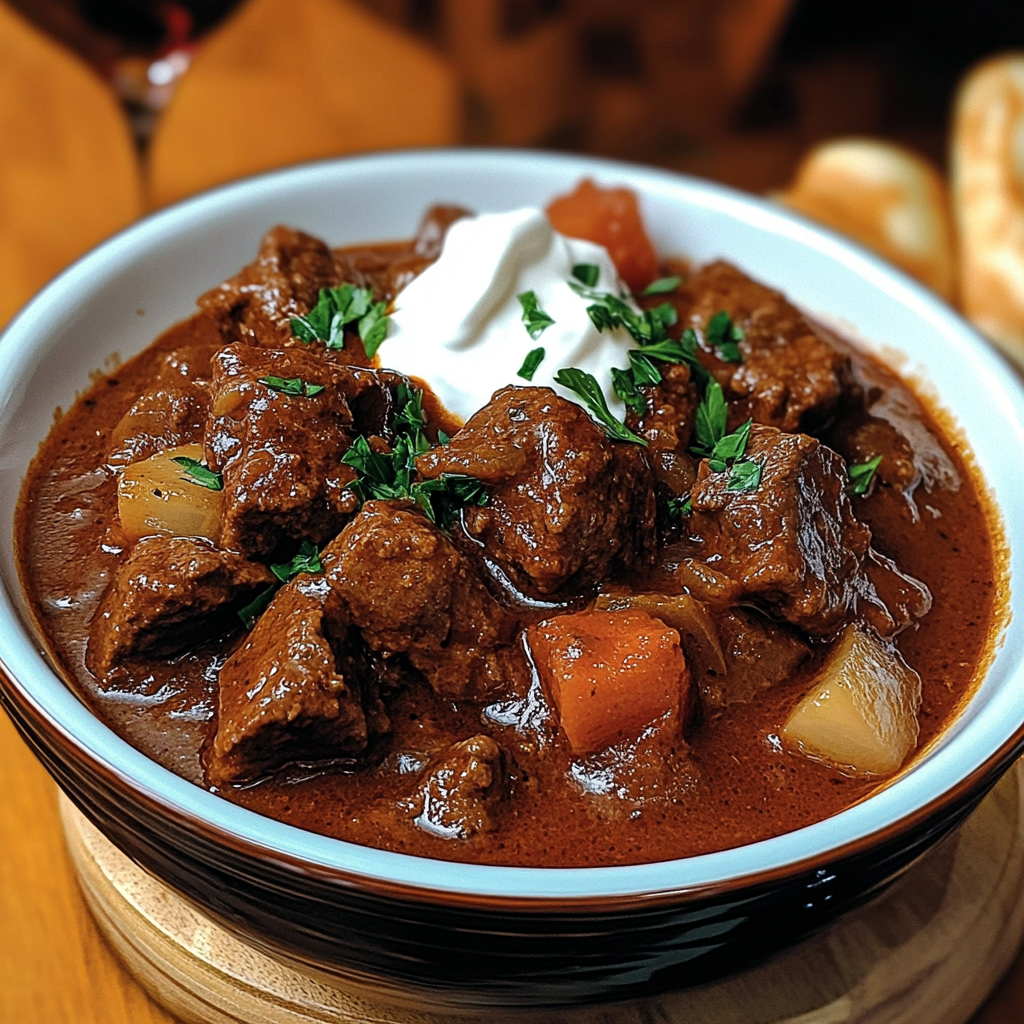Homemade Gulasch is the ultimate comfort food, bringing together deep, rich flavors and a satisfying warmth that makes it perfect for any occasion. With roots tracing back to Hungary, this iconic dish has gained popularity across the globe, adapting to different tastes and traditions along the way. Whether you’re making an authentic Hungarian Gulyás or a variation influenced by different cuisines, Gulasch offers a delightful blend of tender meat, aromatic spices, and a savory, slow-cooked broth. Its versatility allows for endless customization, making it a beloved favorite in kitchens worldwide.

The Roots of Homemade Gulasch
Gulasch has deep historical roots, dating back to the 9th century when Hungarian herdsmen, known as gulyás, first prepared this hearty dish. These cattle herders cooked simple yet flavorful stews over open fires, using beef, onions, and paprika, which would later become the defining spice of the dish. The stew was slow-cooked until the meat became tender, creating a rich and satisfying meal that could sustain them on long journeys.
Over the centuries, Gulasch spread beyond Hungary, evolving as it reached Austria, Germany, and other parts of Central and Eastern Europe. Each region adapted the recipe to suit local tastes and available ingredients. For example, Austrian Gulasch often features a thicker, gravy-like consistency, while German variations may include potatoes, carrots, or even beer for added depth of flavor.
In modern times, Gulasch has even inspired American-style goulash, a one-pot comfort dish typically made with ground beef, macaroni, and tomatoes. While different from the original, it carries the same spirit of hearty, slow-cooked comfort food.
For those who love creamy and slow-cooked meals, you might also enjoy this Creamy Slow Cooker Chicken recipe, which uses similar techniques to develop deep, rich flavors perfect for cozy meals.
Key Ingredients for Perfect Homemade Gulasch
To make the most delicious Homemade Gulasch, you’ll need:
- Beef: A well-marbled cut like chuck ensures tender bites.
- Paprika: Sweet or hot paprika is essential for an authentic taste.
- Onions and Garlic: The foundation of this savory stew.
- Tomato Paste: Adds depth and richness to the base.
- Herbs and Spices: Bay leaves, caraway seeds, and marjoram add layers of flavor.
If you’re interested in more ways to combine creamy elements and bold flavors, the Baked Macaroni and Cheese recipe is an excellent example of how comfort food can shine with a well-rounded flavor profile.
How to Make Homemade Gulasch
1. Prepare Your Ingredients for Homemade Gulasch
- Dice onions and garlic, and cut beef into cubes.
- Measure your spices, ensuring balance between sweet and spicy.
2. Start Cooking
Brown the Beef and Onions
- Heat oil in a large pot. Sauté onions and garlic until fragrant, then add the beef and brown evenly.
Add Paprika and Tomato Paste
- Stir in your paprika and tomato paste, letting the flavors blend for a rich aroma.
Simmer the Stew
- Add beef stock, bay leaves, and other spices. Reduce heat and let it simmer for 1.5–2 hours, stirring occasionally.
3. Final Touches
- Adjust seasoning to taste and serve with dumplings, rice, or crusty bread.
For more inspiration on pairing hearty dishes with versatile sides, explore the Creamy Chicken Tetrazzini recipe, which showcases how creamy bases elevate comfort meals.

Tips for Perfecting Homemade Gulasch
Here are some key tips for perfecting homemade Gulasch:
- Choose the Right Paprika – Use a mix of sweet and hot paprika for a well-rounded, authentic flavor. Hungarian paprika is ideal.
- Simmer Slowly – Cook on low heat for an extended period to achieve tender meat and a deeply flavorful sauce.
- Prep Ahead – Gulasch tastes even better the next day as the flavors have more time to blend. Consider making it in advance.
- Use the Right Meat – Opt for well-marbled cuts like beef chuck or pork shoulder for the best texture.
- Sauté the Onions Well – Cook onions until golden brown before adding other ingredients; they form the base of the sauce.
- Don’t Rush the Liquid – Add broth or water gradually to maintain a thick, rich consistency.
- Season in Layers – Add salt, pepper, and spices at different stages to develop depth of flavor.
- Serve Traditionally – Pair with dumplings, potatoes, or crusty bread to soak up the delicious sauce.
Enjoy your homemade Gulasch!
Variations to Try Homemade Gulasch
Here are some variations of Homemade Gulasch you can try:
- Vegetarian Gulasch: Swap the beef for mushrooms or lentils and use vegetable stock for a rich, meat-free alternative.
- Spicy Gulasch: Add hot paprika or chili flakes to bring some heat to your dish.
- American-Style Goulash: This variation is a quick and easy one-pot meal, popular in the United States. Instead of the traditional slow-cooked beef stew, elbow macaroni is added directly into the pot, absorbing the flavors of the sauce. Ground beef is commonly used instead of stew meat for faster cooking. The dish is often made with tomato sauce, diced tomatoes, and Italian seasonings like basil and oregano. Some versions include cheese, making it a comforting and satisfying meal.
Expanded FAQs for Homemade Gulasch
1. Can I make Gulasch in advance?
Yes! Gulasch tastes even better the next day because the flavors have more time to meld. After cooking, allow the dish to cool completely, then store it in an airtight container in the refrigerator. Reheat gently on the stove or in the microwave, adding a splash of water or stock to maintain the consistency.
2. What is the best type of beef for Gulasch?
Cuts like chuck, brisket, or round are ideal for Gulasch because they become tender during slow cooking. These cuts are flavorful and break down beautifully when simmered for extended periods. Avoid lean cuts like sirloin, as they can become tough.
3. How can I thicken Gulasch?
If your Gulasch is too thin, you can:
- Simmer uncovered to reduce liquid.
- Stir in a slurry of flour or cornstarch mixed with cold water.
- Add a scoop of mashed potatoes for a natural thickening effect.
4. Can I use pork or chicken instead of beef?
Yes, Gulasch can be made with pork or chicken. Pork shoulder or chicken thighs work best, as they stay moist during cooking. However, the flavor profile will be slightly different compared to traditional beef Gulasch.
5. Is Gulasch gluten-free?
Traditional Gulasch is naturally gluten-free if you skip using flour or bread for thickening. Ensure that your beef stock and spices are gluten-free, as some store-bought versions may contain hidden gluten.
6. How can I make Gulasch vegetarian or vegan?
Replace the beef with hearty vegetables like mushrooms, eggplant, or potatoes. Lentils and chickpeas also make great protein-packed substitutes. Use vegetable stock instead of beef stock, and opt for plant-based oils or butter substitutes.
7. What side dishes pair well with Gulasch?
Homemade Gulasch pairs beautifully with:
- Crusty bread for dipping.
- Egg noodles or spaetzle (German dumplings).
- Mashed or boiled potatoes.
- Steamed rice or polenta.
- Light salads, like cucumber or coleslaw, for contrast.
8. Can I freeze Gulasch?
Absolutely! Gulasch freezes well for up to 3 months. Cool it completely, portion it into airtight containers or freezer bags, and label with the date. Thaw overnight in the refrigerator and reheat on the stove for best results.
9. What is the difference between Hungarian Gulyás and Austrian Gulasch?
Hungarian Gulyás is traditionally a soup with more broth, vegetables like potatoes and carrots, and seasoned with sweet paprika. Austrian Gulasch is a thicker, richer stew that often includes tomato paste and fewer vegetables.
10. How can I add more flavor to my Gulasch?
To enhance the flavor:
- Use high-quality Hungarian paprika for authenticity.
- Sear the beef well for a caramelized base.
- Add a splash of red wine or balsamic vinegar for depth.
- Stir in a dollop of sour cream for creaminess before serving.

Conclusion
Homemade Gulasch is much more than a simple stew—it’s a dish steeped in history, culture, and comfort. Its origins as a humble meal for Hungarian herdsmen have transformed into a globally celebrated recipe, loved for its rich, warming flavors and versatility. From the traditional Hungarian Gulyás to its thicker European variations, and even the American-style one-pot meal, Homemade Gulasch offers something for everyone.
Crafting a perfect Gulasch requires a few key ingredients—high-quality paprika, tender cuts of beef, and slow, patient simmering to bring out the best flavors. This dish is as flexible as it is satisfying, making it a staple for family dinners, holiday gatherings, or cozy nights at home. You can customize it to suit your taste, from vegetarian options to spicier versions for those who love heat.
Pair your Gulasch with soft dumplings, crusty bread, or a creamy side dish like Baked Macaroni and Cheese for a hearty, unforgettable meal. Alternatively, explore the vibrant, creamy layers of Chicken Tetrazzini for a new take on comfort food that pairs well with Gulasch’s bold flavors.
The true beauty of Homemade Gulasch lies in its ability to adapt—whether you follow the traditional path or create your own twist, this dish is a guaranteed crowd-pleaser. So grab your ingredients, let your kitchen fill with the irresistible aroma of simmering stew, and enjoy a meal that embodies both tradition and culinary creativity.
With recipes like Baked Ziti and Gulasch in your repertoire, you’ll never run out of options for comforting, home-cooked meals. Take the first step today and bring the timeless warmth of Gulasch to your table—your family and friends will thank you!
